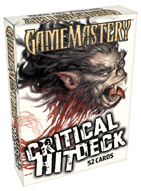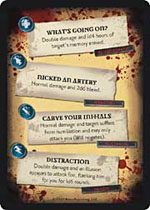by Allan Sugarbaker
 GameMastery: Critical Hit Deck
GameMastery: Critical Hit Deck
Published by Paizo Publishing
Designed by Jason Bulmahn
52 full-color playing cards, & 1 rule card
$9.95
The GameMastery line from Paizo Publishing started down the path to success by providing high-quality map tiles, which at times have accompanied a short d20 adventure. Other handy products filled in the product line, such as Item Cards that gave physical representation to the gear and goodies characters haul around. And even though Paizo’s turn at the helms of Dragon and Dungeon magazines is coming to a close, the company has managed to produce some worthwhile compilations and spin-off products from the near-boundless resource of past issues.
With the GameMastery: Critical Hit Deck, Paizo ventures into variant rules territory (something they’ve proven quite good at in the pages of Dragon), and not just any rules, either. With this deck, the designers propose to replace/extend the D&D rules for critical hits, one of the favorite combat events for any gamer. Does the deck succeed at this task, or fall flat with the most important critical hit critics, the players? Some playtesting showed me what I needed to know.
In the Cards
The GameMastery: Critical Hit Deck is a 52 card full-color deck, with a severed orc head printed on the back as if to warn players what they’re in for. Each card reveals four different combat results, one each for Bludgeoning, Slashing, Piercing, or Magical damage respectively. On a confirmed critical, the player scoring the critical would draw a card and apply the effect appropriate to his damage type instead of just doing straight damage to the target. Weapons that normally have higher damage multipliers (x3 or x4) allow the player to draw two or three cards on a critical and select the effect they want to apply.
Normally, a critical hit’s only effect is extra damage (x2, x3, or x4, depending on the weapon), and higher damage clears the way for the next opponent that much quicker. When special character abilities are factored in – feats, skill tricks, prestige classes, etc – there may be an extra effect or two from a particular character’s criticals. But under the regular rules, the random luck of battle isn’t represented by the combat results. Yes, good or bad rolls randomly determine the battle’s outcome, but especially as character levels increase, players come to know roughly what each hit roll’s result will be. An average roll will usually hit this sort of foe, doing at least x damage, and a critical will do twice that – in situations like these, the combats risk becoming routine.
Life or death struggles should never be routine. If combats are predictable for the players, the gamemaster should just hand out experience and say “You fought some guys and won” rather than waste valuable gaming time.
 With the Critical Hit Deck a wide range of painful blows are possible each time a critical attack happens, without making sweeping changes to the combat rules. Some have interesting game effects – temporary blindness, a broken leg, armor damage, a knockout, the all-time favorite decapitation – some of which give the target a chance to avoid them with a save roll. Others bestow ongoing damage upon the unfortunate victim, usually described as Bleed, which the Deck’s rule card says can only be stopped by a DC 15 Heal check. A few card effects won’t change the combat situation much (how often do you need to deprive a creature of its Swallow Whole attack?), but most are easily factored into the battle with a minimum of creative thinking.
With the Critical Hit Deck a wide range of painful blows are possible each time a critical attack happens, without making sweeping changes to the combat rules. Some have interesting game effects – temporary blindness, a broken leg, armor damage, a knockout, the all-time favorite decapitation – some of which give the target a chance to avoid them with a save roll. Others bestow ongoing damage upon the unfortunate victim, usually described as Bleed, which the Deck’s rule card says can only be stopped by a DC 15 Heal check. A few card effects won’t change the combat situation much (how often do you need to deprive a creature of its Swallow Whole attack?), but most are easily factored into the battle with a minimum of creative thinking.
There are a few particularly nasty blows that can show up when using the full deck: “Severed Spine” causes double damage and 3d6 DEX damage; another result causes Bleed equal to the original blow’s damage each round; and a handful inflict significant CON Bleed, a deadly situation even for high level combatants. These major injury results may scare away some gamemasters who want more control over the mortality rate in their campaigns. In my case, these nasty wound effects make me think back to the critical hits system I used back in 2nd Edition.
I used to keep my copy of Best of Dragon: Volume 5 on hand during every game I ran, just for the article “Critical Hits & Bad Misses”. Players were psyched every time the article came out, already envisioning the gruesome outcome. Once in a while, the result rolled on the tables didn’t make sense for the situation, or was over-the-top lethal in my judgement – in those cases, I’d reroll, thereby reminding my players of the artificial nature of random criticals. The Critical Hit Deck has an advantage of medium over a magazine article: simply put, cards with unwanted results can be removed from the deck – with or without the players’ knowledge, per GM discretion. The cards could be replaced later for the full, deadly experience, or weaker effects swapped out for additional deadly cards from a duplicate deck. The ability to customize the danger level of an encounter is a handy one for gamemasters to have.
Like the other damage types, magical criticals run the gamut, and are largely generic enough to apply to any damage-dealing spell. A few could drastically change the combat, and might best be omitted; a time vortex or planar rift, both potential card results for magical attacks, would suddenly be the focus of attention rather than a compliment to the action. As gamemaster, I’d rather be the one introducing major plot events. I won’t have a random card pull dumping a character into an outer plane.
Taking the hits
For a true playtest, I dropped the cards directly into my ongoing weekly campaign. Critical results came up several times (lucky rolls were plentiful), and my players had mixed reactions to the cards. Like me, a couple of them really liked the unpredictable nature of using the cards, and the way the cards added to the story experience of the combat rather than pure number crunching. At the same time, the players that had built damage-dealing tank characters were a bit annoyed at getting surprising results and situational modifiers instead of the expected big damage payoff. Mind you, big damage is still possible with the cards – and brutal at times – but even after pointing this out, the tank players slightly preferred a predictable damage multiplier. So for my group, we’ve adopted the cards for continued use in the campaign, but I’m allowing players to choose between a card draw and dealing their straight damage.
As to the remaining gameplay concern, are the cards a slower way to deal with critical hits in D&D? Yes, but only slightly. The (admittedly oversimplified) critical rules in the core game are certainly faster, but at the cost of variety. In our games, the cards slowed combat down a fraction until everyone got used to them, but it only took a few skirmishes should bring everyone up to speed again.
Conclusions
When you change the way you handle critical hits in combat, you are fiddling with a fundamental reward of the game. Aside from the overall enjoyment of roleplaying with friends, the Big Three rewards are experience points/gaining levels, loot, and bragging rights. For many players, criticals are a big part of bragging rights, and will be the highlights of stories they tell about the session. For this reason alone – not game balance concerns, not speed-of-play concerns – gamemasters should give the Critical Hit Deck a couple of trial runs with their players before officially adding the cards to their game sessions.
If your players can accept the change of emphasis from big damage numbers to exciting, often tactic-changing effects, consider rewarding them with the entertaining combat results this deck can provide. For groups that want to bring back the wild, unpredictable nature of bloody combat, I highly recommend giving the GameMastery: Critical Hit Deck a try.